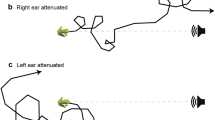Summary
One of the four sound entrances (two posterior tympana and two prothoracic spiracles; Fig. 1) of the auditory system of female field crickets (Gryllus campestris L.) was occluded with wax.
-
1.
After single occlusions and in the absence of external directional stimuli the crickets behave like intact unorientated animals: they do not walk in any consistent direction (Fig. 2). Walking velocity (Fig. 3) is not reduced in comparison with that of intact crickets. Systematic changes in angular velocity do not occur (Fig. 4, Table 1). Thus, unorientated walking is not affected by the occlusion of sound entrances.
-
2.
With calling song presentation, occlusions of one sound entrance (tympanum or spiracle) result in course deviations to the intact side (Figs. 5–7). As in intact, acoustically orientating crickets, oscillations around the mean walking direction occur, accompanied by occasional full turns to the intact side (Figs. 5 and 7). The response mechanism underlying the acoustic orientation of operated crickets is described by the nearly sinusoidal characteristic of their corrective turns (characteristic curve; Fig. 7). After single occlusions, the characteristic curves are shifted by a constant angular velocity towards the intact side. The accuracy of course maintenance is reduced in comparison to that of the intact animals.
-
3.
The functional role of a prothoracic spiracle in hearing is shown to be virtually the same as that of the ipsilateral posterior tympanum. From our behavioural results the question arises, whether tympanal membrane vibration is necessary for the excitation of the auditory sense cells inGryllus campestris. In addition, our results do not support an ipsilateral pressure-gradient mechanism for directional hearing in this species.
Similar content being viewed by others
References
Bailey WJ, Thomson P (1977) Acoustic orientation in the cricketTeleogryllus oceaniens (Le Guillou). J Exp Biol 67:61–75
Eibl E (1978) Morphology of the sense organs in the proximal parts of the tibiae ofGryllus campestris L. andGryllus bimaculatus de Geer (Insecta, Ensifera). Zoomorphologie 89:185–205
Fletcher NH, Thwaites S (1979) Acoustical analysis of the auditory system of the cricketTeleogryllus commodus (Walker). J Acoust Soc Am 66:350–357
Hill KG, Boyan GS (1976) Directional hearing in crickets. Nature 262:390–391
Hill KG, Boyan GS (1977) Sensitivity to frequency and direction of sound in the auditory system of crickets (Gryllidae). J Comp Physiol 121:79–97
Johnstone BM, Saunders JC, Johnstone JR (1970) Tympanic membrane response in the cricket. Nature 227:625–626
Kleindienst H-U (1980) Biophysikalische Untersuchungen am Gehörsystem von Feldgrillen. Dissertation, Universität Bonn
Kleindienst H-U, Koch UT, Wohlers DW (1981) Analysis of the cricket auditory system by acoustic stimulation using a closed sound field. J Comp Physiol 141:283–296
Klopffleisch KD (1973) Ethologische Untersuchungen an der FeldgrilleGryllus campestris L. an natürlichen Standorten. Staatsexamensarbeit, Universität Köln
Kramer E (1975) Orientation of the male silkmoth to the sex attractant bombycol. In:Denton DA, Coghlan JP (eds) Olfaction and taste V. Academic Press, New York, pp 329–335
Kramer E (1976) The orientation of walking honeybees in odour fields with small concentration gradients. Physiol Entomol 1:27–37
Larsen ON (1981) Mechanical time resolution in some insect ears II. Impulse sound transmission in acoustic tracheal tubes. J Comp Physiol 143:297–304
Larsen ON, Michelsen A (1978) Biophysics of the ensiferan ear III. The cricket ear as a four-input system. J Comp Physiol 123:217–227
Michel K (1974) Das Tympanalorgan vonGryllus bimaculatus DeGeer (Saltatoria, Gryllidae). Z Morphol Tiere 77:285–315
Moiseff A, Pollack GS, Hoy RR (1978) Steering responses of flying crickets to sound and ultrasound: Mate attraction and predator avoidance. Proc Natl Acad Sci USA 75:4052–4056
Murphey RK, Zaretsky MD (1972) Orientation to calling song by female crickets,Scapsipedus marginatus (Gryllidae). J Exp Biol 56:335–352
Nocke H (1972) Physiological aspects of sound communication in crickets (Gryllus campestris L.). J Comp Physiol 80:141–162
Paton JA, Capranica RR, Dragsten PR, Webb WW (1977) Physical basis for auditory frequency analysis in field crickets (Gryllidae). J Comp Physiol 119:221–240
Regen J (1923) Über die Orientierung des Weibchens vonLiogryllus campestris L. nach dem Stridulationsschall des Männchens. Sitzungsber Akad Wiss Wien 132:81–88
Schmitz B (1979) Untersuchungen zur Phonotaxis bei der Feldgrille (Gryllus campestris L.). Diplomarbeit, Universität Köln
Schmitz B, Scharstein H (1981) Mechanismus der akustischen Orientierung bei Grillen-Weibchen (Grylluscampestris L.). Verh Dtsch Zool Ges 1981:267
Schmitz B, Scharstein H, Wendler G (1982) Phonotaxis inGryllus campestris L. (Orlhoptera, Gryllidae) I. Mechanism of acoustic orientation in intact female crickets. J Comp Physiol 148:431–444
Schumacher R (1978) Morphologisch-cylologischer Vergleich der Tympana verschiedener Orthopteren (Tettigonioidea, Grylloidea, Gryllotalpidae, Acridioidea). Zool Anz 201:323–340
Thorson J, Weber T, Huber F (1982) Auditory behaviour of the cricket. II. Simplicity of calling song recognition inGryllus, and anomalous phonotaxis at abnormal carrier frequencies. J Comp Physiol 146:361–378
Wendler G, Dambach M, Schmitz B, Scharstein H (1980) Analysis of the acoustic orientation behaviour in crickets (Grylluscampestris L.). Naturwissenschaften 67:99–100
Zaretsky MD (1972) Specificity of the calling song and short term changes in the phonotactic response by female cricketsScapsipedus marginatus (Gryllidae). J Comp Physiol 79:153–172
Zhantiev RD, Kalinkina IN, Chukanov VS (1975) Characteristics of the directional sensitivity of the tympanal organs in the cricketGryllus bimaculatus Deg. (Orthoptera, Gryllidae). Entomol Obozr 54:249–257
Author information
Authors and Affiliations
Rights and permissions
About this article
Cite this article
Schmitz, B., Scharstein, H. & Wendler, G. Phonotaxis inGryllus campestris L. (Orthoptera, Gryllidae). J. Comp. Physiol. 152, 257–264 (1983). https://doi.org/10.1007/BF00611190
Accepted:
Issue Date:
DOI: https://doi.org/10.1007/BF00611190




